The Influence of Glacier Mass Balance on River Runoff in the Typical Alpine Basin
Abstract
:1. Introduction
2. Data and Methods
2.1. Study Area
2.2. Datasets
2.3. Methods
2.3.1. Production of DEM through InSAR Method
2.3.2. InSAR DEM Accuracy Assessment
2.3.3. DEM Co-Registration
- Use equation to obtain the distribution areas of PNT (Positive and Negative Terrain), where “MEAN” is a 12 × 12 rectangular average value data layer obtained from DEM data through neighborhood statistics analysis;
- Extract the ridgeline by using , where SOA (Slope of Aspect) is the planar curvature, calculated by 1 to obtain the DEM data layer “IDEM” (Inverse DEM) that is inverse to the original DEM, using the equation ;
- Use the ArcGIS slope tool to extract slope direction data “Aspect” from “IDEM” data, and use slope tool to extract slope “SOA2” from “Aspect” data;
- Perform the same operation as in 3 on the original DEM data to obtain “SOA1”;
- Use equation to obtain the planar curvature SOA.
2.3.4. GSE Change Error Correction
- The SRTM-X band DEM raster data of the study area were converted to point features in ArcGIS 10.5 with corresponding longitude and latitude attributes added;
- Based on the point feature’s longitude and latitude co-ordinates, the Geoid height function was used to calculate the difference in elevation between the EGM96 geodetic datum and the WGS84 ellipsoid datum;
- The elevation values of the point feature were then calculated for the EGM96 elevation reference;
- The point features were converted into raster data based on the elevation reference generated on the EGM96 at a resolution of 20 m.
2.3.5. GSE Change Error Correction Based on Ice Thickness Data
2.3.6. GSE Change Error Correction Based on GSE Change Regularity
2.3.7. GSE Change and GMB Estimation
3. Results
3.1. Accuracy Assessment for InSAR DEM Based on ICESat-2
3.2. Analysis of Co-Registration and Correction Results
3.3. Analysis of GSE Change Optimization Results
3.4. Analysis of GSE and GMB Change Results
4. Discussions
4.1. Influence of Climate on GSE Change
4.2. Influence of Topographic Factors on GSE Change
4.2.1. Influence of Altitude on GSE Change
4.2.2. Influence of Slope and Aspect on GSE Change
4.3. Influence of GMB on River Runoff
5. Conclusions
- Considering the terrain differences between various types of DEMs, this paper presents a mountain ridge registration method that uses planar curvature and slope to generate mountain ridges from InSAR DEM, ALOS DEM, and NASA DEM data. The extracted mountain ridge samples are screened, fitted, and used for DEM registration based on their respective mountain ridge locations. This approach significantly improves the precision of GSE change monitoring.
- This paper proposes a glacier-thickness-data-based approach for processing glacier elevation abnormal values. The processed data result in a decrease of the standard deviation of GSE at different periods by approximately 31%, 25%, and 28%, respectively. These findings suggest that abnormal values reduction based on glacier thickness data can improve the accuracy of GSE change studies.
- This paper uses GSE change data to estimate the average annual thinning rates of glaciers for the periods 2000–2009, 2009–2022, and 2000–2022, with reduction values of−0.29 ± 0.14 m·a−1, −0.17 ± 0.07 m·a−1, and −0.25 ± 0.02 m·a−1, respectively. The result shows that glaciers experience faster surface elevation changes in areas with lower slopes, and north-facing glaciers show higher surface thinning rates. Over the past 22 years, most glaciers in the Tailan River basin have exhibited a decline in GSE. As altitude increases, the GSE decline rate slows down, and GSE changing values shift from negative to positive.
- This paper investigates the GMB changes in the study area and explored the factors that influence GMB changes, in conjunction with climate change and runoff in the basin. The results show that from 2000 to 2009, 2009 to 2022, and 2000 to 2022, the GMB change in the Tailan River basin was −0.34 ± 0.05 m w.e.a−1, −0.19 ± 0.10 m w.e.a−1, and −0.30 ± 0.02 m w.e.a−1, respectively. The result show that the GMB in the study area was in a significant negative state. From 2000 to 2009, the average annual temperature in the Tailan River basin showed a weak upward trend with a rate of 0.08 °C·a−1. The annual total precipitation exhibited a declining trend with a rate of 3.2 mm·a−1. From 2000 to 2009, the change in runoff of the Tailan River basin was 2.71 × 107 m3, glacial meltwater was about 6.89 × 107 m3, and the largest proportion of glacial meltwater recharge was about 54.92% from 2000 to 2009. From 2009 to 2022, the runoff of the Tailan River basin was 1.45 × 108 m3, and glacier meltwater accounted for approximately 47.76% of that. From 2000 to 2022, the proportion of glacier meltwater accounted for 46.15% of the runoff in the basin.
Author Contributions
Funding
Data Availability Statement
Acknowledgments
Conflicts of Interest
References
- Miles, E.; McCarthy, M.; Dehecq, A.; Kneib, M.; Fugger, S.; Pellicciotti, F. Health and sustainability of glaciers in High Mountain Asia. Nat. Commun. 2021, 12, 2868. [Google Scholar] [CrossRef] [PubMed]
- Bhattacharya, A.; Bolch, T.; Mukherjee, K.; King, O.; Menounos, B.; Kapitsa, V.; Neckel, N.; Yang, W.; Yao, T. High Mountain Asian glacier response to climate revealed by multi-temporal satellite observations since the 1960s. Nat. Commun. 2021, 12, 4133. [Google Scholar] [CrossRef]
- Francis, J.A.; Skific, N.; Vavrus, S.J. Increased persistence of large-scale circulation regimes over Asia in the era of amplified Arctic warming, past and future. Sci. Rep. 2020, 10, 14953. [Google Scholar] [CrossRef] [PubMed]
- Marzeion, B.; Jarosch, A.H.; Gregory, J.M. Feedbacks and mechanisms affecting the global sensitivity of glaciers to climate change. Cryosphere 2014, 8, 59–71. [Google Scholar] [CrossRef] [Green Version]
- Yao, T.; Thompson, L.; Yang, W.; Yu, W.; Gao, Y.; Guo, X.; Yang, X.; Duan, K.; Zhao, H.; Xu, B.; et al. Different glacier status with atmospheric circulations in Tibetan Plateau and surroundings. Nat. Clim. Chang. 2012, 2, 663–667. [Google Scholar] [CrossRef]
- Narama, C.; Kääb, A.; Duishonakunov, M.; Abdrakhmatov, K. Spatial variability of recent glacier area changes in the Tien Shan Mountains, Central Asia, using Corona (~1970), Landsat (~2000), and ALOS (~2007) satellite data. Glob. Planet. Chang. 2010, 71, 42–54. [Google Scholar] [CrossRef]
- Pieczonka, T.; Bolch, T.; Junfeng, W.; Shiyin, L. Heterogeneous mass loss of glaciers in the Aksu-Tarim Catchment (Central Tien Shan) revealed by 1976 KH-9 Hexagon and 2009 SPOT-5 stereo imagery. Remote Sens. Environ. 2013, 130, 233–244. [Google Scholar] [CrossRef] [Green Version]
- Shangguan, D.; Liu, S.; Ding, Y.; Ding, L.; Xiong, L.; Cai, D.; Li, G.; Lu, A.; Zhang, S.; Zhang, Y. Monitoring the glacier changes in the Muztag Ata and Konggur mountains, east Pamirs, based on Chinese Glacier Inventory and recent satellite imagery. Ann. Glaciol. 2006, 43, 79–85. [Google Scholar] [CrossRef] [Green Version]
- Brun, F.; Berthier, E.; Wagnon, P.; Kääb, A.; Treichler, D. A spatially resolved estimate of High Mountain Asia glacier mass balances from 2000 to 2016. Nat. Geosci. 2017, 10, 668–673. [Google Scholar] [CrossRef] [Green Version]
- Gardelle, J.; Berthier, E.; Arnaud, Y.; Kääb, A. Region-wide glacier mass balances over the Pamir-Karakoram-Himalaya during 1999–2011. Cryosphere 2013, 7, 1263–1286. [Google Scholar] [CrossRef] [Green Version]
- Gardner, A.S.; Moholdt, G.; Cogley, J.G.; Wouters, B.; Arendt, A.A.; Wahr, J.; Berthier, E.; Hock, R.; Pfeffer, W.T.; Kaser, G.; et al. A Reconciled Estimate of Glacier Contributions to Sea Level Rise: 2003 to 2009. Science 2013, 340, 852–857. [Google Scholar] [CrossRef] [PubMed] [Green Version]
- Sherpa, S.F.; Wagnon, P.; Brun, F.; Berthier, E.; Vincent, C.; Lejeune, Y.; Arnaud, Y.; Kayastha, R.B.; Sinisalo, A. Contrasted surface mass balances of debris-free glaciers observed between the southern and the inner parts of the Everest region (2007–15). J. Glaciol. 2017, 63, 637–651. [Google Scholar] [CrossRef] [Green Version]
- Immerzeel, W.W.; Lutz, A.F.; Andrade, M.; Bahl, A.; Biemans, H.; Bolch, T.; Hyde, S.; Brumby, S.; Davies, B.J.; Elmore, A.C.; et al. Importance and vulnerability of the world’s water towers. Nature 2020, 577, 364–369. [Google Scholar] [CrossRef]
- Zhou, Y.; Li, Z.; Li, J.; Zhao, R.; Ding, X. Glacier mass balance in the Qinghai–Tibet Plateau and its surroundings from the mid-1970s to 2000 based on Hexagon KH-9 and SRTM DEMs. Remote Sens. Environ. 2018, 210, 96–112. [Google Scholar] [CrossRef]
- Bolch, T.; Yao, T.; Kang, S.; Buchroithner, M.F.; Scherer, D.; Maussion, F.; Huintjes, E.; Schneider, C. A glacier inventory for the western Nyainqentanglha Range and the Nam Co Basin, Tibet, and glacier changes 1976–2009. Cryosphere 2010, 4, 419–433. [Google Scholar] [CrossRef] [Green Version]
- Scherler, D.; Bookhagen, B.; Strecker, M.R. Spatially variable response of Himalayan glaciers to climate change affected by debris cover. Nat. Geosci. 2011, 4, 156–159. [Google Scholar] [CrossRef]
- Huss, M. Density assumptions for converting geodetic glacier volume change to mass change. Cryosphere 2013, 7, 877–887. [Google Scholar] [CrossRef] [Green Version]
- Mayr, E.; Hagg, W. Debris-Covered Glaciers. In Geomorphology of Proglacial Systems: Landform and Sediment Dynamics in Recently Deglaciated Alpine Landscapes; Heckmann, T., Morche, D., Eds.; Springer International Publishing: Cham, Switzerland, 2019; pp. 59–71. [Google Scholar]
- Thibert, E.; Blanc, R.; Vincent, C.; Eckert, N. Glaciological and volumetric mass-balance measurements: Error analysis over 51 years for Glacier de Sarennes, French Alps. J. Glaciol. 2008, 54, 522–532. [Google Scholar] [CrossRef] [Green Version]
- Du, W.; Zheng, Y.; Li, Y.; Bao, A.; Li, J.; Ma, D.; Gao, X.; Pan, Y.; Wang, S. Recent Seasonal Spatiotemporal Variations in Alpine Glacier Surface Elevation in the Pamir. Remote Sens. 2022, 14, 4923. [Google Scholar] [CrossRef]
- Wang, P.; Xing, C.; Pan, X. Reservoir Dam Surface Deformation Monitoring by Differential GB-InSAR Based on Image Subsets. Sensors 2020, 20, 396. [Google Scholar] [CrossRef] [Green Version]
- Yan, L.; Wang, J.; Shao, D. Glacier Mass Balance in the Manas River Using Ascending and Descending Pass of Sentinel 1A/1B Data and SRTM DEM. Remote Sens. 2022, 14, 1506. [Google Scholar] [CrossRef]
- Khasanov, K.; Masharif, B. Vertical Accuracy of Freely Available Global Digital Elevation Models: A Case Study in Karaman Water Reservoir Territory. Int. J. Geoinformatics 2022, 18, 53–61. [Google Scholar]
- Sadhasivam, N.; Periasamy, T.; Rahaman, S.A.; Rajagopal, J. Erosion risk assessment through morphometric indices for prioritisation of Arjuna watershed using ALOS-PALSAR DEM. Model. Earth Syst. Environ. 2019, 5, 907–924. [Google Scholar] [CrossRef]
- Uuemaa, E.; Ahi, S.; Montibeller, B.; Muru, M.; Kmoch, A. Vertical Accuracy of Freely Available Global Digital Elevation Models (ASTER, AW3D30, MERIT, TanDEM-X, SRTM, and NASADEM). Remote Sens. 2020, 12, 3482. [Google Scholar] [CrossRef]
- Tachikawa, T.; Kaku, M.; Iwasaki, A.; Gesch, D.; Oimoen, M.; Zhang, Z.; Danielson, J.; Krieger, T.; Curtis, B.; Haase, J. ASTER Global Digital Elevation Model Version 2—Summary of Validation Results; NASA: Washington, DC, USA, 2011. [Google Scholar]
- Kyriou, A.; Nikolakopoulos, K. Assessing the suitability of Sentinel-1 data for landslide mapping. Eur. J. Remote Sens. 2018, 51, 402–411. [Google Scholar] [CrossRef] [Green Version]
- Mäkynen, M.; Karvonen, J. Incidence Angle Dependence of First-Year Sea Ice Backscattering Coefficient in Sentinel-1 SAR Imagery Over the Kara Sea. IEEE Trans. Geosci. Remote Sens. 2017, 55, 6170–6181. [Google Scholar] [CrossRef]
- Mu, C.; Peng, X.; Du, R.; Liu, H.; Jin, H.; Liang, B.; Mu, M.; Sun, W.; Fan, C.; Wu, X.; et al. A Comprehensive Dataset for Earth System Models in a Permafrost Region: Meteorological, Permafrost, and Carbon Observations (2011–2020) in Northeastern Qinghai-Tibet Plateau. Earth Syst. Sci. Data Discuss. 2022, 2022, 1–32. [Google Scholar] [CrossRef]
- Xu, S.; Wang, Y.; Wang, Y.; Qi, S.; Zhou, M. Glacier Mass Balance Changes Over the Turgen Daban Range, Western Qilian Shan, From 1966/75 to 2020. Front. Earth Sci. 2022, 10, 848895. [Google Scholar] [CrossRef]
- Gao, X.; Ye, B.; Zhang, S.; Qiao, C.; Zhang, X. Glacier runoff variation and its influence on river runoff during 1961–2006 in the Tarim River Basin, China. Sci. China Earth Sci. 2010, 53, 880–891. [Google Scholar] [CrossRef]
- Braithwaite, R.J.; Zhang, Y. Sensitivity of mass balance of five Swiss glaciers to temperature changes assessed by tuning a degree-day model. J. Glaciol. 2000, 46, 7–14. [Google Scholar] [CrossRef] [Green Version]
- Pope, A. GLOSSARY OF GLACIER MASS BALANCE AND RELATED TERMS. J.G. Cogley, R. Hock, L.A. Rasmussen, A.A. Arendt, A. Bauder, R.J. Braithwaite, P. Jansson, G. Kaser, M. Möller, L. Nicholson, and M. Zemp. 2011. Paris: UNESCO-IHP (IHP-VII Technical documents in hydrology 86, IACS contribution 2), vi + 114p, illustrated, soft cover. Polar Rec. 2012, 48, e15. [Google Scholar] [CrossRef] [Green Version]
- Ahluwalia, R.S.; Rai, S.P.; Meetei, P.N.; Kumar, S.; Sarangi, S.; Chauhan, P.; Karakoti, I. Spatial-diurnal variability of snow/glacier melt runoff in glacier regime river valley: Central Himalaya, India. Quat. Int. 2021, 585, 183–194. [Google Scholar] [CrossRef]
- Radić, V.; Hock, R. Glaciers in the Earth’s Hydrological Cycle: Assessments of Glacier Mass and Runoff Changes on Global and Regional Scales. Surv. Geophys. 2014, 35, 813–837. [Google Scholar] [CrossRef]
- Van Pelt, W.J.J.; Pohjola, V.A.; Pettersson, R.; Ehwald, L.E.; Reijmer, C.H.; Boot, W.; Jakobs, C.L. Dynamic Response of a High Arctic Glacier to Melt and Runoff Variations. Geophys. Res. Lett. 2018, 45, 4917–4926. [Google Scholar] [CrossRef] [Green Version]
- Lutz, A.F.; Immerzeel, W.W.; Shrestha, A.B.; Bierkens, M.F.P. Consistent increase in High Asia’s runoff due to increasing glacier melt and precipitation. Nat. Clim. Change 2014, 4, 587–592. [Google Scholar] [CrossRef] [Green Version]
- Ma, N.; Zhang, Y. Increasing Tibetan Plateau terrestrial evapotranspiration primarily driven by precipitation. Agric. For. Meteorol. 2022, 317, 108887. [Google Scholar] [CrossRef]
- Zhao, J.; Wang, J.; Harbor, J.M.; Liu, S.; Yin, X.; Wu, Y. Quaternary glaciations and glacial landform evolution in the Tailan River valley, Tianshan Range, China. Quat. Int. 2015, 358, 2–11. [Google Scholar] [CrossRef]
- Yongping, S.; Zichu, X.; Liangfu, D.; Jingshi, L. Estimation of Average Mass Balance for Glaciers in a Water Shed and Its Application. J. Glaciol. Geocryol. 1997, 19, 302–307. [Google Scholar]
- Shen, Y.P.; Liu, S.Y.; Ding, Y.J.; Wang, S. Glacier Mass Balance Change in Tailanhe River Watersheds on the South Slope of the Tianshan Mountains and Its Impact on Water Resources. J. Glaciol. Geocryol. 2003, 25, 124–129. [Google Scholar] [CrossRef]
- Liu, S.; Ding, Y.; Zhang, Y.; Shangguan, D.; Li, J.; Han, H.; Wang, J.; Xie, C. Impact of the glacial change on water resources in the Tarim River Basin. Acta Geogr. Sin. 2006, 61, 482–490. [Google Scholar]
- Zhao, G.; Zhang, Z.; Liu, L.; Li, Z.; Wang, P.; Xu, L. Simulation and construction of the glacier mass balance in the Manas River Basin, Tianshan, China from 2000 to 2016. J. Geogr. Sci. 2020, 30, 988–1004. [Google Scholar] [CrossRef]
- Wu, P.; Shu, L.; Yang, C.; Xu, Y.; Zhang, Y. Simulation of groundwater flow paths under managed abstraction and recharge in an analogous sand-tank phreatic aquifer. Hydrogeol. J. 2019, 27, 3025–3042. [Google Scholar] [CrossRef]
- Chang, L.; Chen, Y.-T.; Wang, J.-H.; Chang, Y.-L. Rice-Field Mapping with Sentinel-1A SAR Time-Series Data. Remote Sens. 2021, 13, 103. [Google Scholar] [CrossRef]
- Aðalgeirsdóttir, G.; Magnússon, E.; Pálsson, F.; Thorsteinsson, T.; Belart, J.M.C.; Jóhannesson, T.; Hannesdóttir, H.; Sigurðsson, O.; Gunnarsson, A.; Einarsson, B.; et al. Glacier Changes in Iceland From ~1890 to 2019. Front. Earth Sci. 2020, 8, 523646. [Google Scholar] [CrossRef]
- Zhang, T.; Shen, W.-B.; Wu, W.; Zhang, B.; Pan, Y. Recent Surface Deformation in the Tianjin Area Revealed by Sentinel-1A Data. Remote Sens. 2019, 11, 130. [Google Scholar] [CrossRef] [Green Version]
- Yague-Martinez, N.; Prats-Iraola, P.; Gonzalez, F.; Brcic, R.; Shau, R.; Geudtner, D.; Eineder, M.; Bamler, R. Interferometric Processing of Sentinel-1 TOPS Data. IEEE Trans. Geosci. Remote Sens. 2016, 54, 2220–2234. [Google Scholar] [CrossRef] [Green Version]
- Zhou, M.; Xu, S.; Wang, Y.; Wang, Y.; Hou, S. Recent 50-Year Glacier Mass Balance Changes over the Yellow River Source Region, Determined by Remote Sensing. Remote Sens. 2022, 14, 6286. [Google Scholar] [CrossRef]
- Paul, F.; Bolch, T.; Kääb, A.; Nagler, T.; Nuth, C.; Scharrer, K.; Shepherd, A.; Strozzi, T.; Ticconi, F.; Bhambri, R.; et al. The glaciers climate change initiative: Methods for creating glacier area, elevation change and velocity products. Remote Sens. Environ. 2015, 162, 408–426. [Google Scholar] [CrossRef] [Green Version]
- Chen, F.; Wang, J.; Li, B.; Yang, A.; Zhang, M. Spatial variability in melting on Himalayan debris-covered glaciers from 2000 to 2013. Remote Sens. Environ. 2023, 291, 113560. [Google Scholar] [CrossRef]
- Du, W.; Liu, X.; Guo, J.; Shen, Y.; Li, W.; Chang, X. Analysis of the melting glaciers in Southeast Tibet by ALOS-PALSAR data. Terr. Atmos. Ocean. Sci. 2019, 30, 7–19. [Google Scholar] [CrossRef] [Green Version]
- Wang, L.; Marzahn, P.; Bernier, M.; Jacome, A.; Poulin, J.; Ludwig, R. Comparison of TerraSAR-X and ALOS PALSAR Differential Interferometry with Multisource DEMs for Monitoring Ground Displacement in a Discontinuous Permafrost Region. IEEE J. Sel. Top. Appl. Earth Obs. Remote Sens. 2017, 10, 4074–4093. [Google Scholar] [CrossRef]
- Yilmaz, M. Accuracy assessment of temperature trends from ERA5 and ERA5-Land. Sci. Total Environ. 2023, 856, 159182. [Google Scholar] [CrossRef] [PubMed]
- Hussain, M.A.; Azam, M.F.; Srivastava, S.; Vinze, P. Positive mass budgets of high-altitude and debris-covered fragmented tributary glaciers in Gangotri Glacier System, Himalaya. Front. Earth Sci. 2022, 10, 978836. [Google Scholar] [CrossRef]
- Ramirez, S.G.; Hales, R.C.; Williams, G.P.; Jones, N.L. Extending SC-PDSI-PM with neural network regression using GLDAS data and Permutation Feature Importance. Environ. Model. Softw. 2022, 157, 105475. [Google Scholar] [CrossRef]
- Muhammad, S.; Tian, L.; Khan, A. Early twenty-first century glacier mass losses in the Indus Basin constrained by density assumptions. J. Hydrol. 2019, 574, 467–475. [Google Scholar] [CrossRef]
- Welty, E.; Zemp, M.; Navarro, F.; Huss, M.; Fürst, J.; Gärtner-Roer, I.; Landmann, J.; Machguth, H.; Naegeli, K.; Andreassen, L.M.; et al. Worldwide version-controlled database of glacier thickness observations. Earth Syst. Sci. Data 2020, 12, 3039–3055. [Google Scholar] [CrossRef]
- Rehman, K.; Fareed, N.; Chu, H.-J. NASA ICESat-2: Space-Borne LiDAR for Geological Education and Field Mapping of Aeolian Sand Dune Environments. Remote Sens. 2023, 15, 2882. [Google Scholar] [CrossRef]
- Ferretti, A.; Monti-Guarnieri, A.; Prati, C.; Rocca, F.; Massonet, D. InSAR Principles—Guidelines for SAR Interferometry Processing and Interpretation; ESA Publication: Noordwijk, The Netherlands, 2007. [Google Scholar]
- Malik, K.; Kumar, D. High Resolution Interferometric Digital Elevation Model Generation and Validation. Int. Arch. Photogramm. Remote Sens. Spat. Inf. Sci. 2018, 42, 755–756. [Google Scholar] [CrossRef] [Green Version]
- Tang, X.; Zhou, P.; Zhang, G.; Wang, X.; Jiang, Y.; Guo, L.; Liu, S. Verification of ZY-3 Satellite Imagery Geometric Accuracy Without Ground Control Points. IEEE Geosci. Remote Sens. Lett. 2015, 12, 2100–2104. [Google Scholar] [CrossRef]
- Yue, L.; Shen, H.; Zhang, L.; Zheng, X.; Zhang, F.; Yuan, Q. High-quality seamless DEM generation blending SRTM-1, ASTER GDEM v2 and ICESat/GLAS observations. ISPRS J. Photogramm. Remote Sens. 2017, 123, 20–34. [Google Scholar] [CrossRef]
- Li, Y.; Fu, H.; Zhu, J.; Wu, K.; Yang, P.; Wang, L.; Gao, S. A Method for SRTM DEM Elevation Error Correction in Forested Areas Using ICESat-2 Data and Vegetation Classification Data. Remote Sens. 2022, 14, 3380. [Google Scholar] [CrossRef]
- Gardelle, J.; Berthier, E.; Arnaud, Y. Impact of resolution and radar penetration on glacier elevation changes computed from DEM differencing. J. Glaciol. 2012, 58, 419–422. [Google Scholar] [CrossRef] [Green Version]
- Paul, F. Calculation of glacier elevation changes with SRTM: Is there an elevation-dependent bias? J. Glaciol. 2008, 54, 945–946. [Google Scholar] [CrossRef] [Green Version]
- Farinotti, D.; Huss, M.; Bauder, A.; Funk, M.; Truffer, M. A method to estimate the ice volume and ice-thickness distribution of alpine glaciers. J. Glaciol. 2009, 55, 422–430. [Google Scholar] [CrossRef] [Green Version]
- Denzinger, F.; Machguth, H.; Barandun, M.; Berthier, E.; Girod, L.; Kronenberg, M.; Usubaliev, R.; Hoelzle, M. Geodetic mass balance of Abramov Glacier from 1975 to 2015. J. Glaciol. 2021, 67, 331–342. [Google Scholar] [CrossRef]
- Huss, M.; Bauder, A.; Funk, M. Homogenization of long-term mass-balance time series. Ann. Glaciol. 2009, 50, 198–206. [Google Scholar] [CrossRef] [Green Version]
- Bolch, T.; Pieczonka, T.; Mukherjee, K.; Shea, J. Brief communication: Glaciers in the Hunza catchment (Karakoram) have been nearly in balance since the 1970s. Cryosphere 2017, 11, 531–539. [Google Scholar] [CrossRef] [Green Version]
- Zhang, H.; Li, Z.Q.; Zhou, P.; Zhu, X.F.; Wang, L. Mass-balance observations and reconstruction for Haxilegen Glacier No. 51, eastern Tien Shan, from 1999 to 2015. J. Glaciol. 2018, 64, 689–699. [Google Scholar] [CrossRef] [Green Version]
- Liu, L.; Tian, H.; Zhang, X.Y.; Chen, H.J.; Zhang, Z.Y.; Zhao, G.N.; Kang, Z.W.; Wang, T.X.; Gao, Y.; Yu, F.C.; et al. Analysis of Spatiotemporal Heterogeneity of Glacier Mass Balance on the Northern and Southern Slopes of the Central Tianshan Mountains, China. Water 2022, 14, 1601. [Google Scholar] [CrossRef]
- Berthier, E.; Cabot, V.; Vincent, C.; Six, D. Decadal Region-Wide and Glacier-Wide Mass Balances Derived from Multi-Temporal ASTER Satellite Digital Elevation Models. Validation over the Mont-Blanc Area. Front. Earth Sci. 2016, 4, 63. [Google Scholar] [CrossRef] [Green Version]
- Zhou, Y.; Li, X.; Zheng, D.; Zhang, X.; Wang, Y.; Ren, S.; Guo, Y. Decadal Changes in Glacier Area, Surface Elevation and Mass Balance for 2000–2020 in the Eastern Tanggula Mountains Using Optical Images and TanDEM-X Radar Data. Remote Sens. 2022, 14, 506. [Google Scholar] [CrossRef]
- Liu, L.; Jiang, L.; Zhang, Z.; Wang, H.; Ding, X. Recent Accelerating Glacier Mass Loss of the Geladandong Mountain, Inner Tibetan Plateau, Estimated from ZiYuan-3 and TanDEM-X Measurements. Remote Sens. 2020, 12, 472. [Google Scholar] [CrossRef] [Green Version]
- Abdullah, T.; Romshoo, S.A.; Rashid, I. The satellite observed glacier mass changes over the Upper Indus Basin during 2000–2012. Sci. Rep. 2020, 10, 14285. [Google Scholar] [CrossRef] [PubMed]
- Zhang, Y.; Luo, Y.; Sun, L.; Liu, S.; Chen, X.; Wang, X. Using glacier area ratio to quantify effects of melt water on runoff. J. Hydrol. 2016, 538, 269–277. [Google Scholar] [CrossRef]
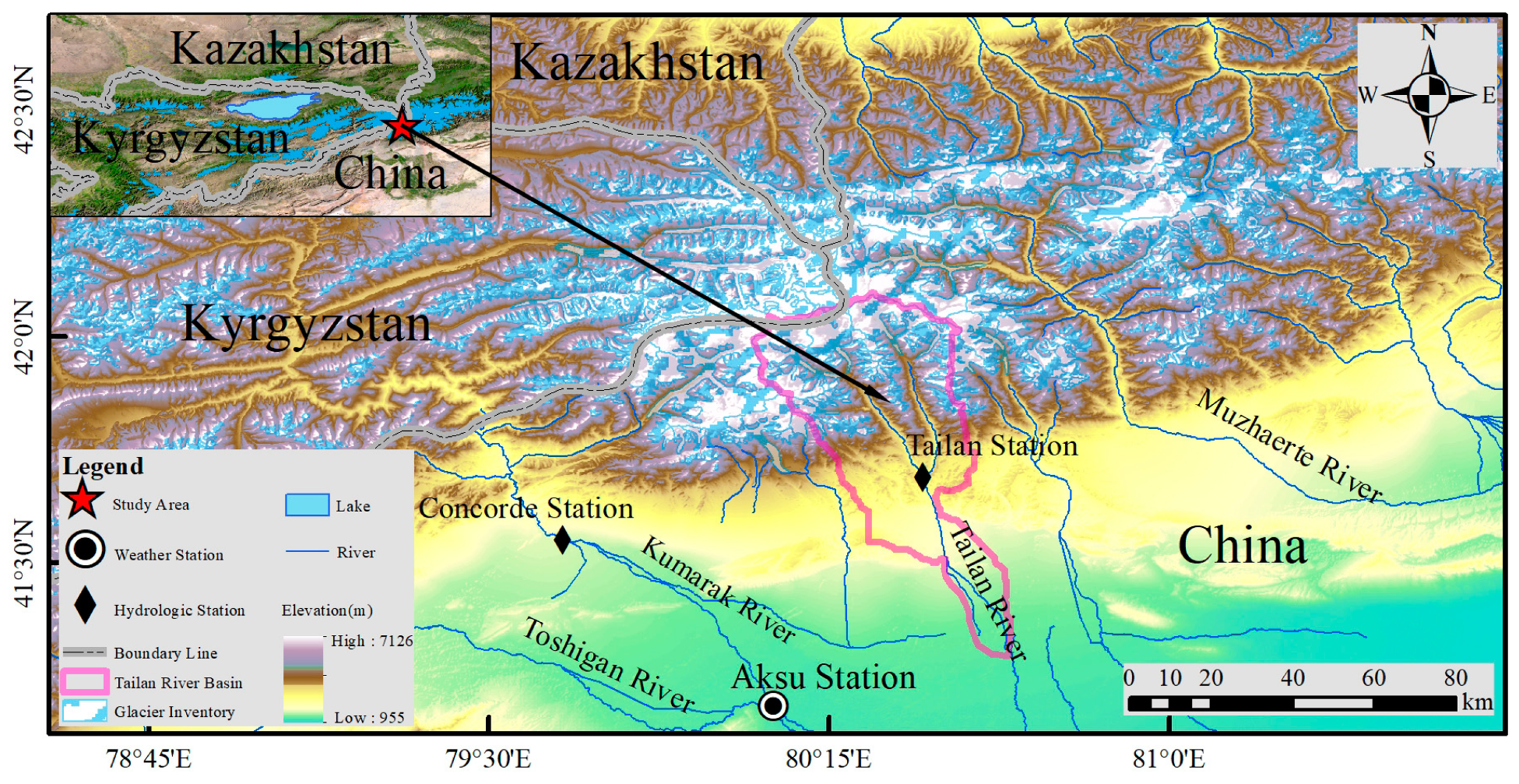
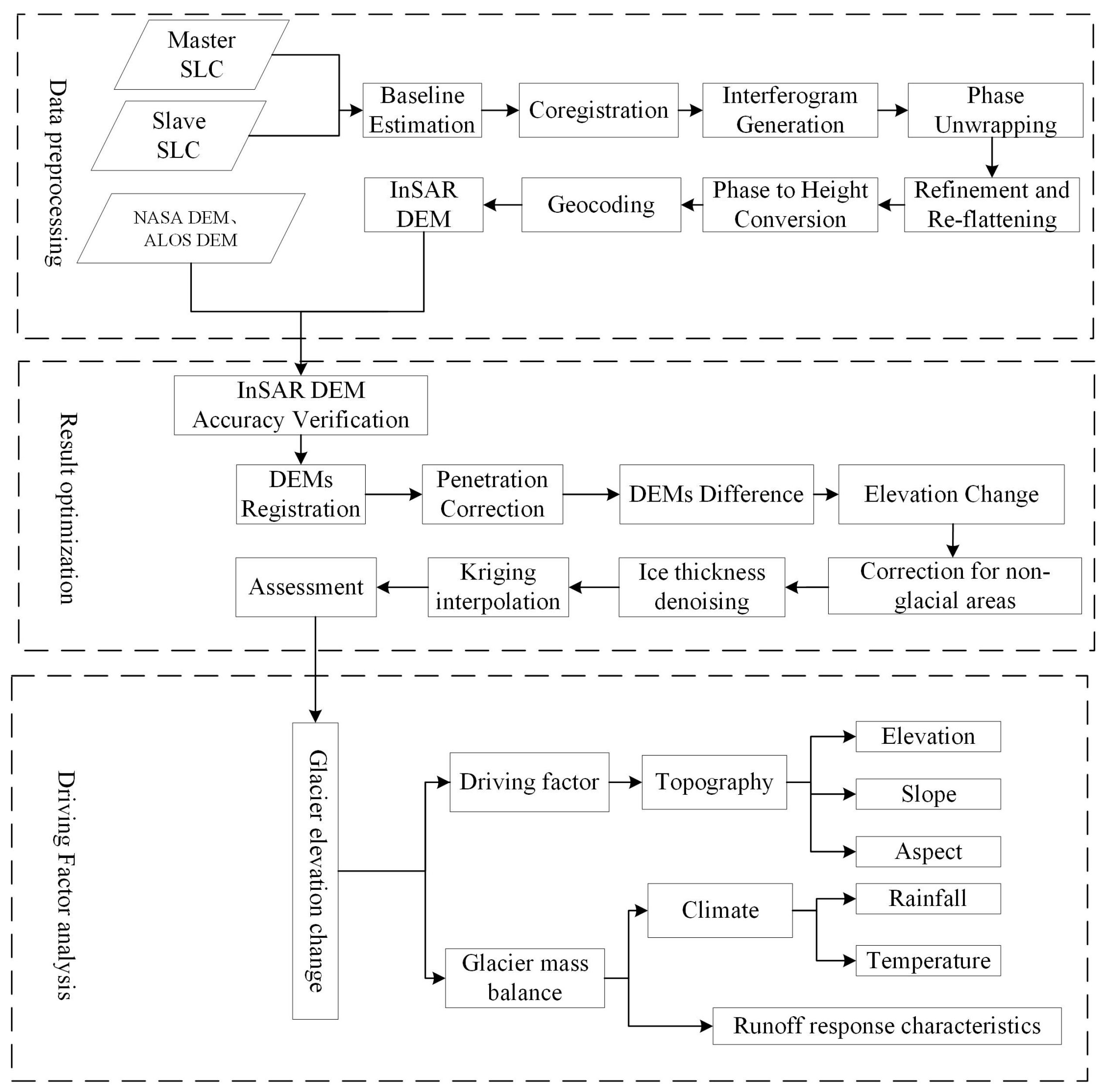
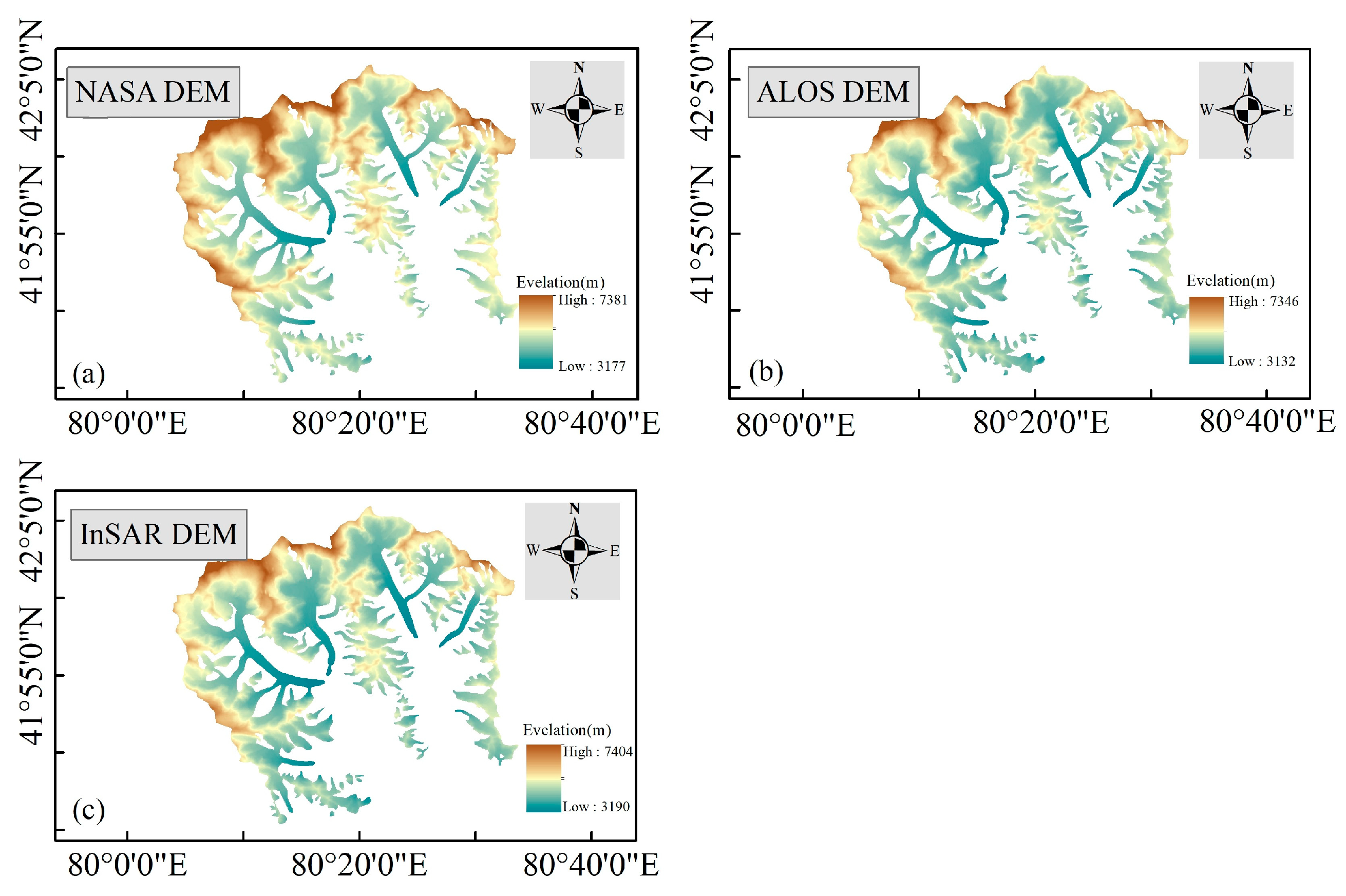

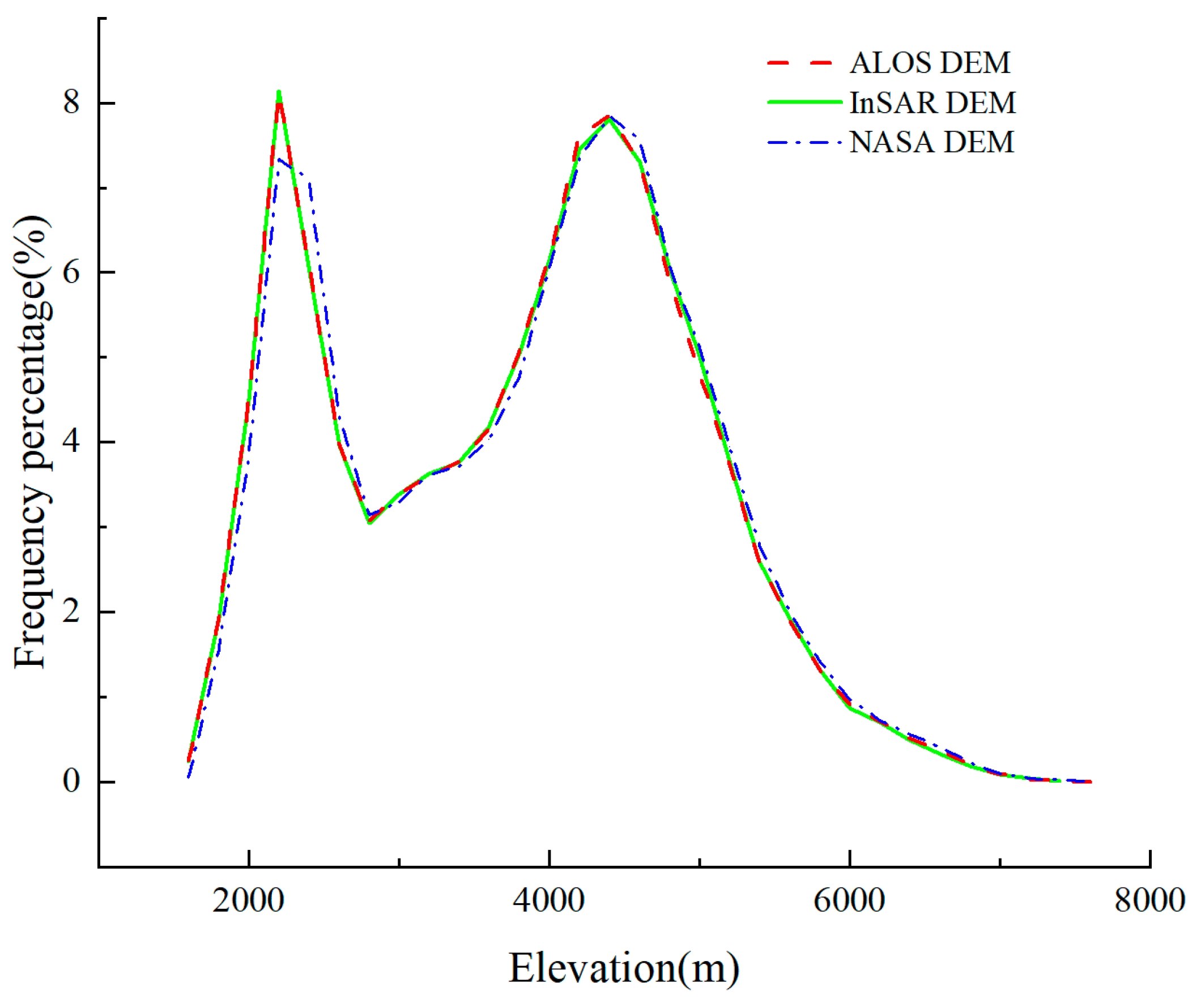

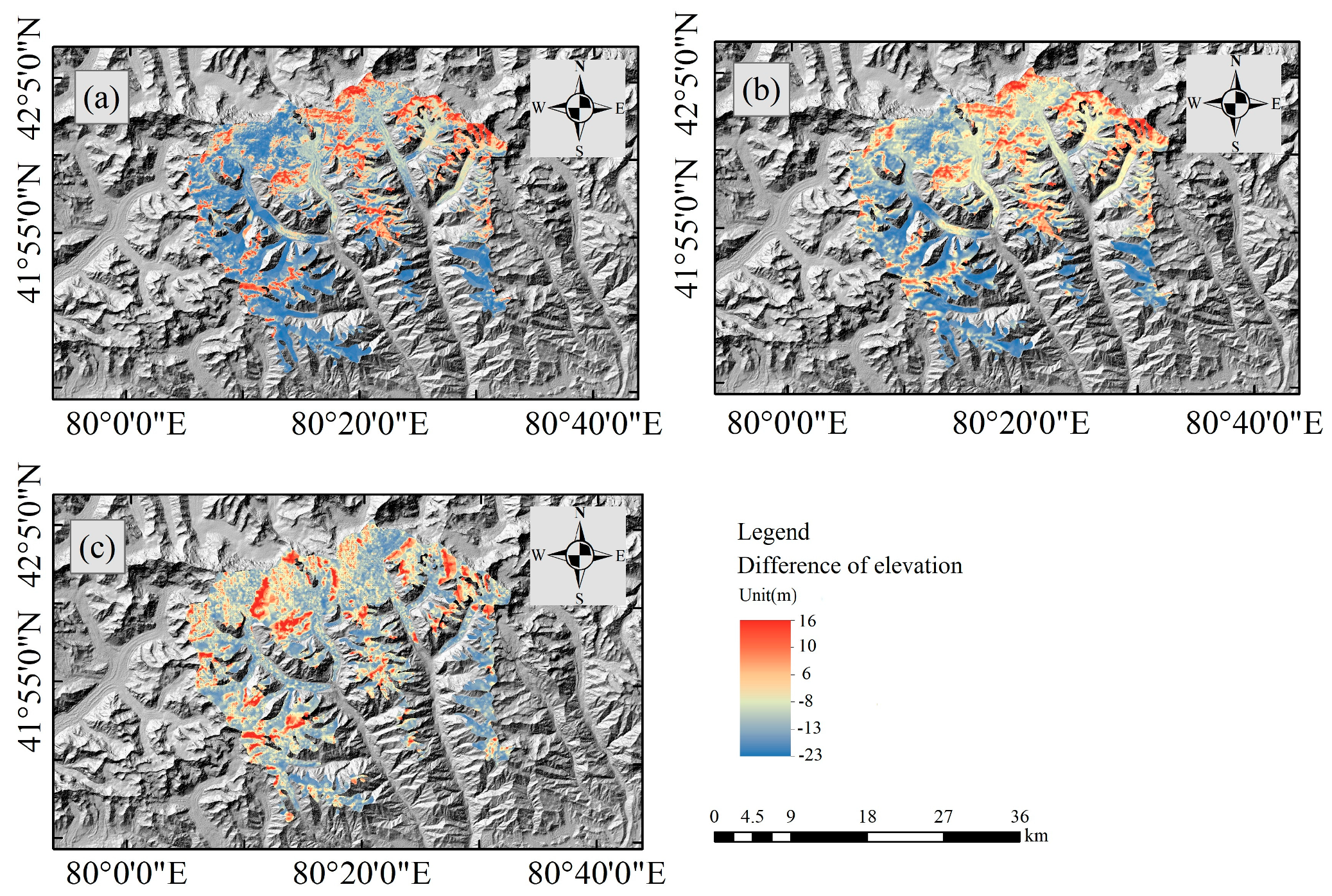


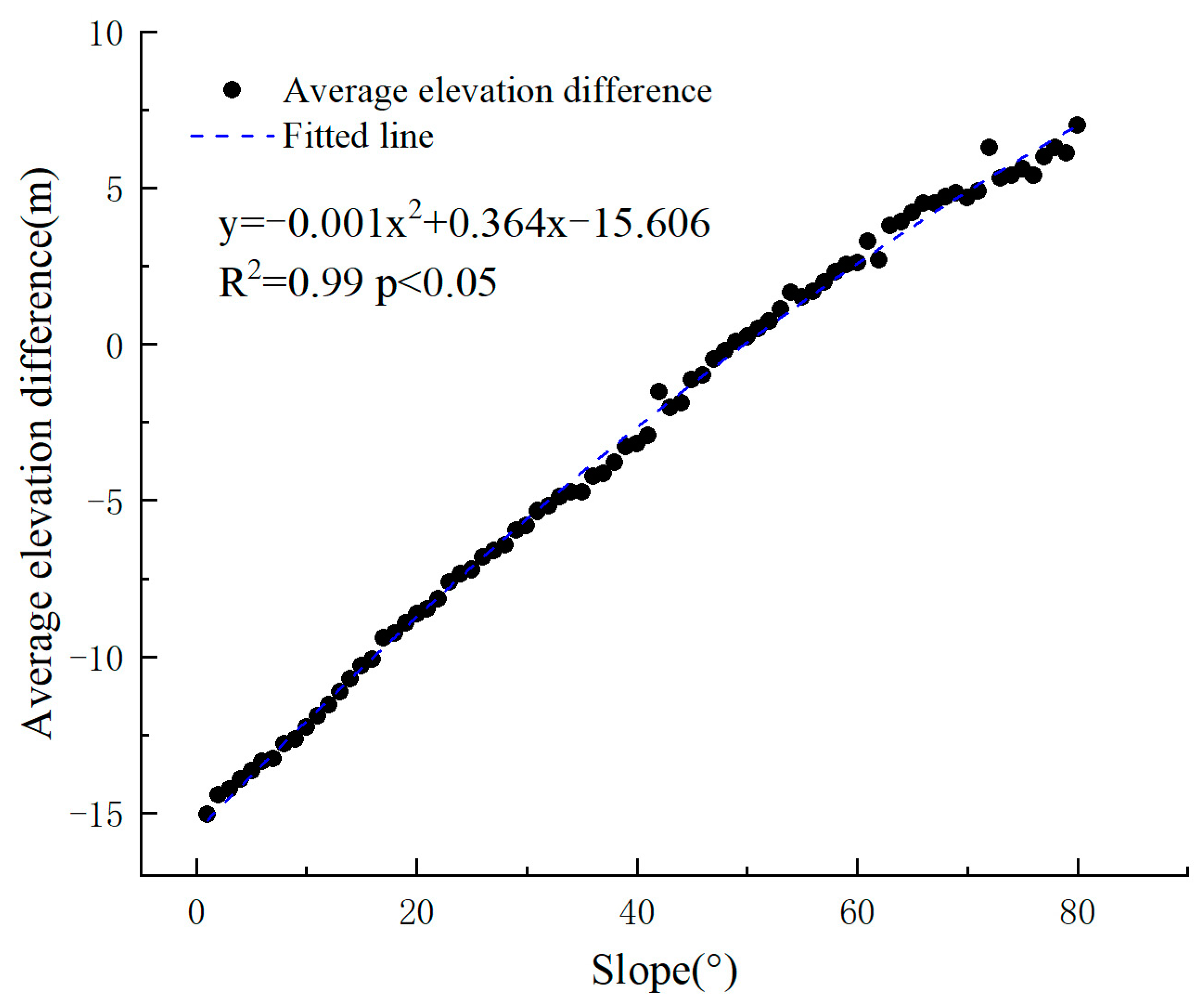
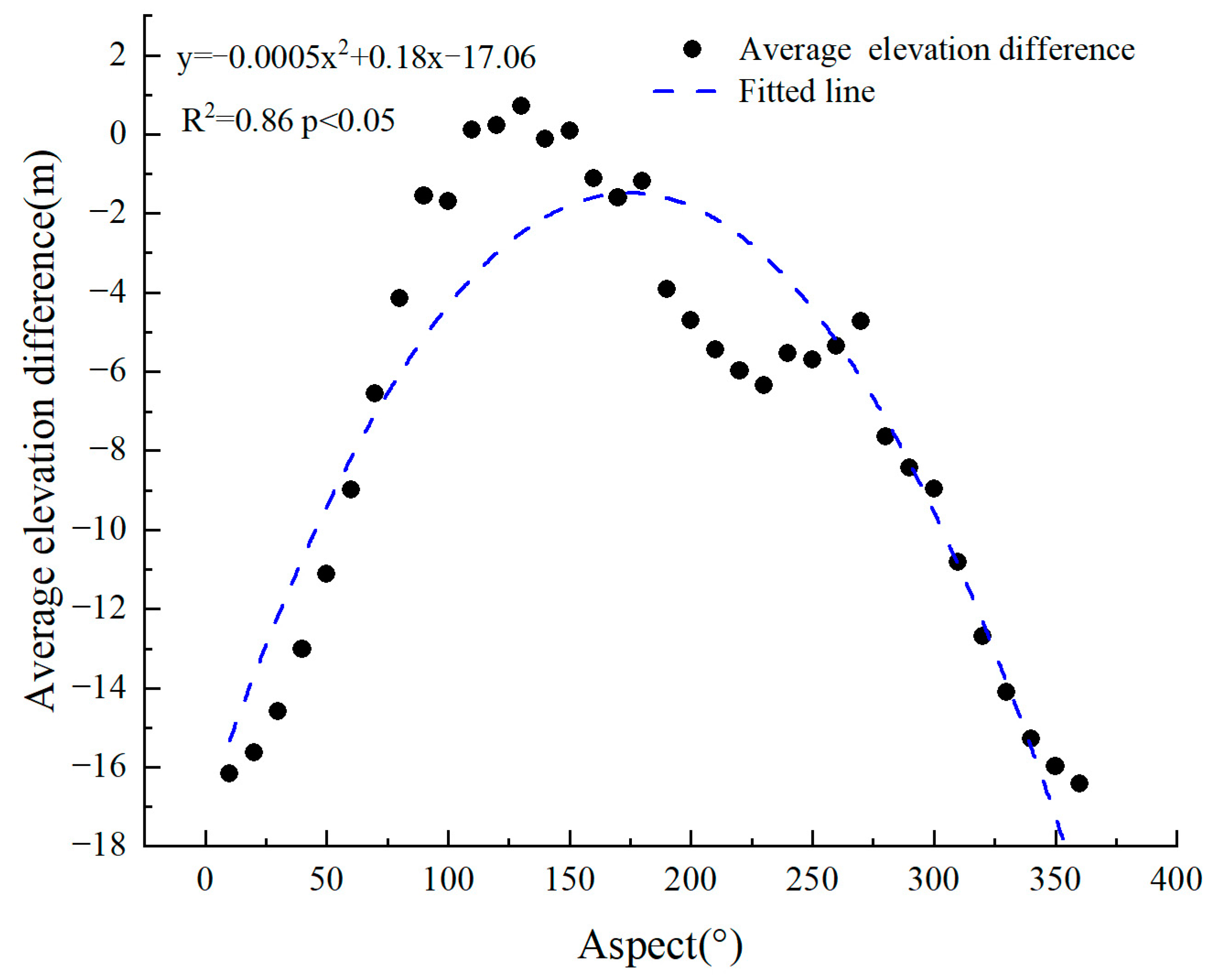
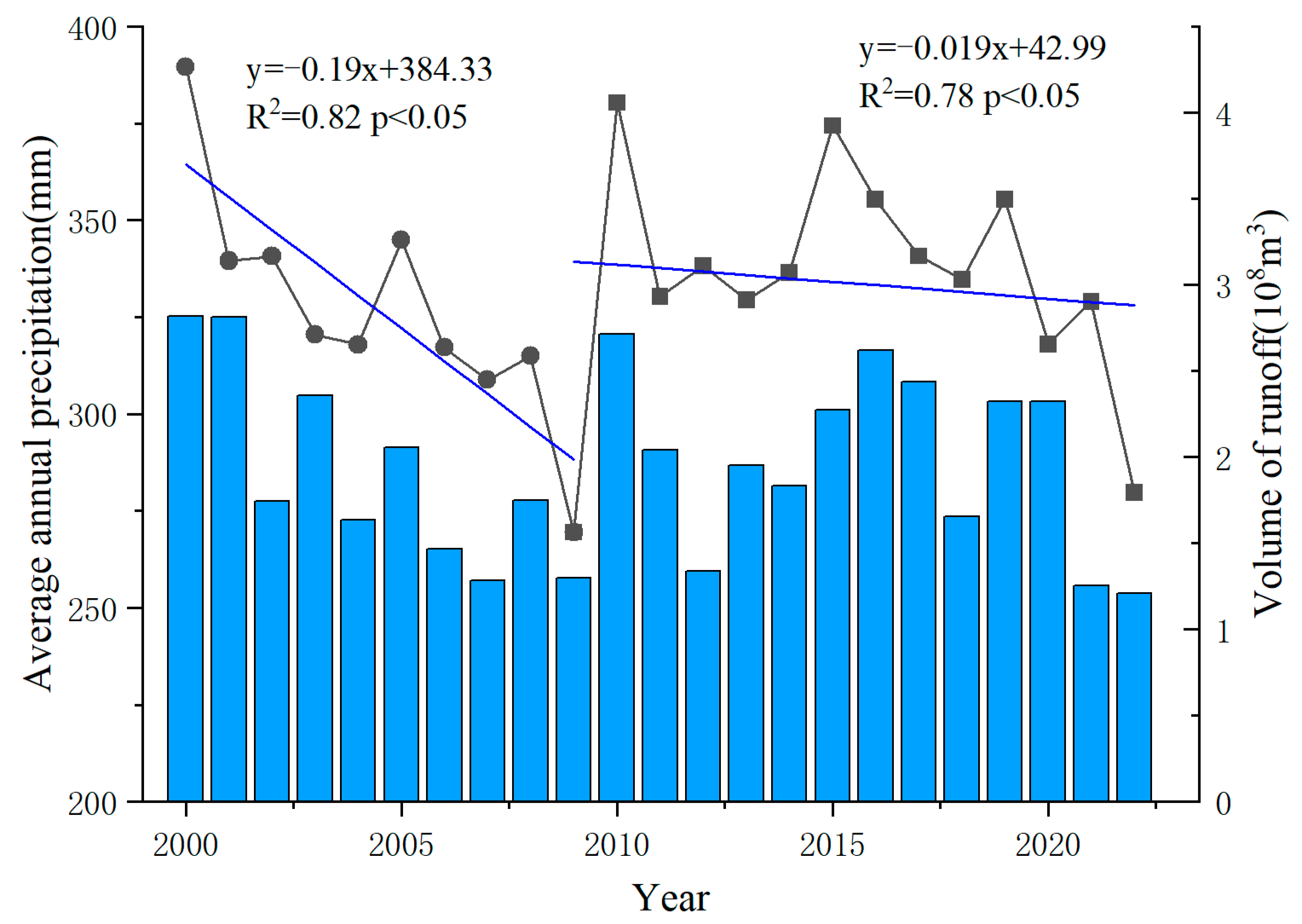
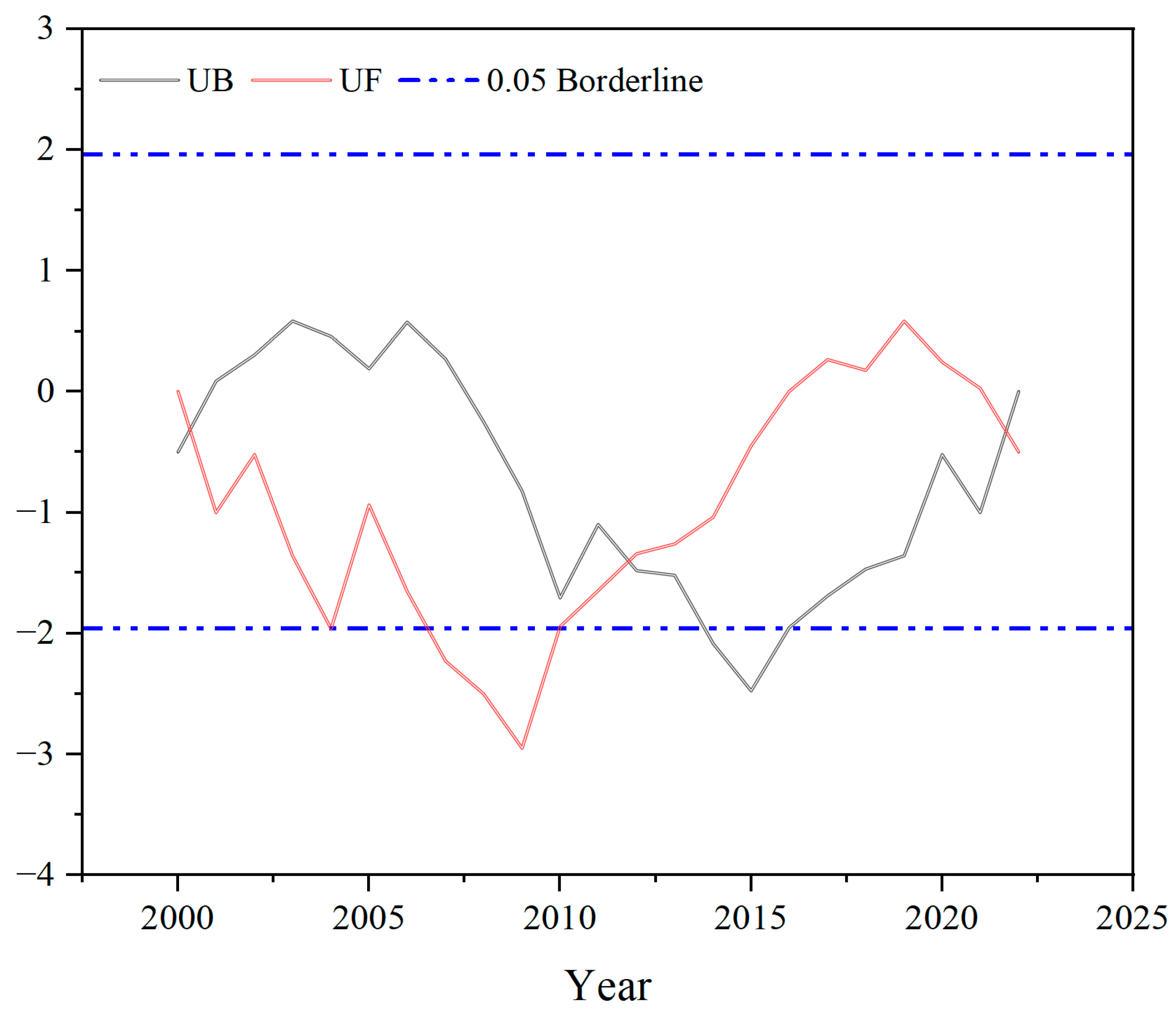
| Data | Date | Data Sources |
|---|---|---|
| Sentinel-1A | February 2022 | https://search.asf.alaska.edu/ (accessed on 1 August 2022) |
| C-band NASA DEM | February 2000 | https://search.earthdata.nasa.gov/ (accessed on 1 August 2022) |
| X-band SRTM DEM | February 2000 | https://geoservice.dlr.de/egp/ (accessed on 1 August 2022) |
| ALOS DEM | February 2009 | https://search.asf.alaska.edu/ (accessed on 1 August 2022) |
| ERA5 | 2000 to 2022 | https://cds.climate.copernicus.eu/ (accessed on 15 August 2022) |
| GLDAS | 2000 to 2022 | https://ldas.gsfc.nasa.gov/data/ (accessed on 16 August 2022) |
| RGI 6.0 | July 2017 | http://www.glims.org/RGI/ (accessed on 1 August 2022) |
| ICESat-2 | September 2021 to February 2022 | https://nsidc.org/home (accessed on 10 August 2022) |
| Sensor | Acquisition | Pass | Polarisation | Beam Mode |
|---|---|---|---|---|
| Sentinel-1A | 12 February 2022 | Ascending | VV | IW |
| Sentinel-1A | 24 February 2022 | Ascending | VV | IW |
| InSAR DEM | Min (m) | Max (m) | Mean (m) | STD (m) | RMSE (m) |
|---|---|---|---|---|---|
| ICESat-2 | −31.21 | 23.44 | −7.48 | 14.24 | 14.67 |
| NASA DEM | −37.24 | 26.89 | −6.62 | 15.45 | 16.42 |
| ALOS DEM | −29.01 | 18.58 | −4.91 | 10.54 | 9.87 |
| InSAR DEM | Offsets in x, y, and z Directions | ||
|---|---|---|---|
| x (m) | y (m) | z (m) | |
| NASA DEM | −23.9 | −10.5 | 5.7 |
| ALOS DEM | 3.4 | −6.2 | −9.2 |
| Time | per | ||
|---|---|---|---|
| 2000–2009 | 10.69 | 7.38 | 31 |
| 2009–2022 | 10.54 | 7.90 | 25 |
| 2000–2022 | 15.45 | 11.12 | 28 |
| Altitude Bands (m) | Altitude Bands Area (km2) | 2000–2009 | 2009–2022 | 2000–2022 | |||
|---|---|---|---|---|---|---|---|
| GSE Change (m·a−1) | GMB (m w.e.a−1) | GSE Change (m·a−1) | GMB (m w.e.a−1) | GSE Change (m·a−1) | GMB (m w.e.a−1) | ||
| 3000–3500 | 12.32 | −0.43 | −0.06 | −0.22 | −0.05 | −0.13 | −0.02 |
| 3500–4000 | 70.81 | −0.30 | −0.28 | −0.33 | −0.44 | −0.31 | −0.28 |
| 4000–4500 | 184.28 | −0.32 | −0.85 | −0.32 | −0.38 | −0.24 | −0.64 |
| 4500–5000 | 137.09 | −0.21 | −0.45 | −0.15 | −0.15 | −0.21 | −0.45 |
| >5000 | 108.06 | −0.23 | −0.09 | 0.17 | 0.03 | −0.38 | −0.13 |
| Total | 512.56 | −0.29 | −0.34 | −0.17 | −0.19 | −0.25 | −0.30 |
| Study Area | Time | Altitude (m) | Mean (m·a−1) | Paper |
|---|---|---|---|---|
| Mont Blanc | 2003–2014 | (1500, 4870) | 0.2–0.3 | [73] |
| Tanggula Mountain | 2000–2020 | (5000, 7120) | −0.76 ± 0.05 | [74] |
| Geladandong Mountain | 2012–2018 2000–2018 | (4933, 6555) | −0.55 ± 0.11 −0.28 ± 0.08 | [75] |
| Tianshan | 2000–2016 | (2500, 7530) | −0.28 ± 0.20 | [9] |
| Tailan River basin | 2000–2009 | (944, 7392) | −0.29 ± 0.14 | Research |
| 2009–2022 | −0.17 ± 0.07 | |||
| 2000–2022 | −0.25 ± 0.02 |
| Year | Mass Balance (m w.e.a−1) | Glacier Meltwater (m3) | Annual Average Runoff (m3) | Rate (%) |
|---|---|---|---|---|
| 2000–2009 | −0.34 ± 0.05 | 1.58 × 108 | 2.84 × 108 | 54.92 |
| 2009–2022 | −0.19 ± 0.10 | 6.89 × 107 | 1.45 × 108 | 47.76 |
| 2000–2022 | −0.30 ± 0.02 | 1.38 × 108 | 2.99 × 108 | 46.15 |
Disclaimer/Publisher’s Note: The statements, opinions and data contained in all publications are solely those of the individual author(s) and contributor(s) and not of MDPI and/or the editor(s). MDPI and/or the editor(s) disclaim responsibility for any injury to people or property resulting from any ideas, methods, instructions or products referred to in the content. |
© 2023 by the authors. Licensee MDPI, Basel, Switzerland. This article is an open access article distributed under the terms and conditions of the Creative Commons Attribution (CC BY) license (https://creativecommons.org/licenses/by/4.0/).
Share and Cite
Yang, B.; Du, W.; Li, J.; Bao, A.; Ge, W.; Wang, S.; Lyu, X.; Gao, X.; Cheng, X. The Influence of Glacier Mass Balance on River Runoff in the Typical Alpine Basin. Water 2023, 15, 2762. https://doi.org/10.3390/w15152762
Yang B, Du W, Li J, Bao A, Ge W, Wang S, Lyu X, Gao X, Cheng X. The Influence of Glacier Mass Balance on River Runoff in the Typical Alpine Basin. Water. 2023; 15(15):2762. https://doi.org/10.3390/w15152762
Chicago/Turabian StyleYang, Bin, Weibing Du, Junli Li, Anming Bao, Wen Ge, Shuangting Wang, Xiaoxuan Lyu, Xin Gao, and Xiaoqian Cheng. 2023. "The Influence of Glacier Mass Balance on River Runoff in the Typical Alpine Basin" Water 15, no. 15: 2762. https://doi.org/10.3390/w15152762
APA StyleYang, B., Du, W., Li, J., Bao, A., Ge, W., Wang, S., Lyu, X., Gao, X., & Cheng, X. (2023). The Influence of Glacier Mass Balance on River Runoff in the Typical Alpine Basin. Water, 15(15), 2762. https://doi.org/10.3390/w15152762







